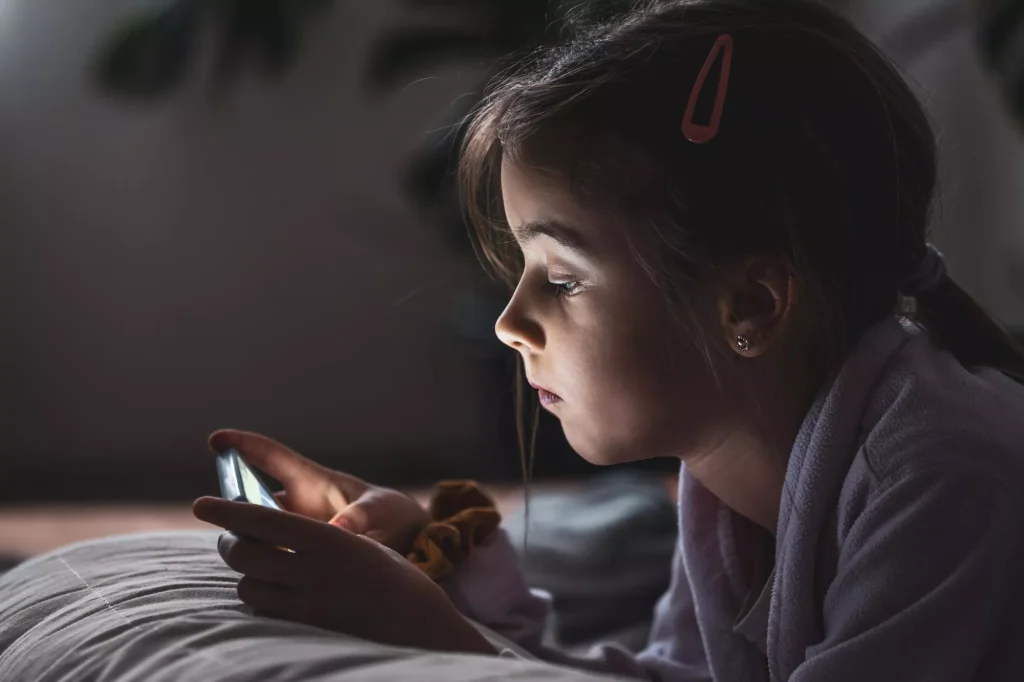How to Balance Screen Time for Kids: A Parent’s Global Guide for Healthy Digital Habits
Screens are everywhere — from tablets and smart TVs to learning apps and online classes.
While technology opens a world of knowledge, too much screen time can affect a child’s sleep, focus, and emotional health.
As a parent, the challenge isn’t removing screens altogether — it’s about balancing exposure with mindful usage.
In this ultimate guide, we’ll explore how to limit screen time for toddlers, build a healthy schedule, and use smart parental control tools to keep your child’s screen time under control — without constant battles.
🪄 Take control of your child’s screen habits with TinyPal App — your intelligent parenting assistant that helps schedule, and guide balanced screen routines worldwide.
Table of Contents
Why Screen Time Balance Matters
According to the World Health Organization (WHO), excessive screen time in children under 5 is linked to developmental delays, irregular sleep, and reduced physical activity.
However, when managed correctly, screen exposure can enhance learning and creativity.
Balance is the keyword — not total restriction.
Key Benefits of Managing Screen Time:
- Promotes better focus and emotional regulation
- Encourages physical activity and outdoor play
- Builds stronger family bonds
- Improves sleep quality
- Reduces behavioral issues

Recommended Screen Time by Age (WHO + AAP Guidelines)
| Age Group | Recommended Daily Screen Time | Expert Notes |
|---|---|---|
| Under 2 years | Avoid screens entirely (except video calls) | Focus on real-world interaction |
| 2–5 years | 1 hour per day maximum | Choose high-quality educational content |
| 6–10 years | 1–2 hours per day | Combine with offline activities |
| 11–17 years | 2 hours (excluding homework) | Prioritize social and physical balance |
📊 AEO Tip: “recommended screen time by age” is a globally high-ranking search intent — aligning this chart with voice and snippet responses improves AI Overview visibility.
Effects of Too Much Screen Time on Children
If your child spends hours glued to devices, here’s what happens over time:
- Sleep Disturbances: Blue light disrupts melatonin, making it hard to sleep.
- Reduced Attention Span: Constant stimulation lowers focus and patience.
- Delayed Social Skills: Less face-to-face communication hinders empathy and social awareness.
- Eye Strain & Posture Issues: Prolonged exposure causes digital fatigue.
- Behavioral Changes: Mood swings and irritability often increase.
💡 Parent Hook: Want real-time alerts on your child’s digital activity?
Try TinyPal App — it intelligently monitors patterns and helps you correct them early.
How to Limit Screen Time for Toddlers
Limiting screens isn’t about control — it’s about creating balance through connection.
1. Be the Role Model
Children copy what they see. Reduce your own screen time first.
2. Set Consistent Routines
Designate “screen-free zones” — mealtime, bedrooms, and family time.
3. Offer Engaging Alternatives
Arts, puzzles, building blocks, or nature walks — replace boredom with creativity.
4. Use Parental Controls Wisely
Don’t rely on bans; use smart apps that guide usage rather than block it entirely.
5. Reward Positive Behavior
Use encouragement instead of punishment.
Example: “You did great playing outside — now let’s watch your favorite show for 20 minutes.”
Tips to Reduce Screen Time for Children
These practical tips work across all age groups and regions — designed from global parenting data and behavioral psychology principles:
- Create Tech-Free Family Activities
Cooking together, gardening, or playing board games builds bonding and fun. - Encourage Offline Learning
Introduce printed books, real-world science experiments, and storytime. - Set Parental Example
Your child will follow your screen behavior subconsciously. - Monitor Content Quality
Educational shows > random entertainment. - Use “Delay Tactics”
When your child asks for a device, offer a 10-minute wait — often, the craving passes.
How to Create a Screen Time Schedule
A structured plan reduces negotiation battles.
Here’s a proven framework parents can follow:
Step 1: Map the Day
Mark meal, play, study, and relaxation slots.
Step 2: Define Digital Time Blocks
Allocate 30–60 minute screen windows — never before bedtime.
Step 3: Involve Your Child
Let them co-create the schedule for better cooperation.
Step 4: Stick to Consistency
Enforce boundaries gently but firmly.
🕒 Smart Hack:
Automate schedules with TinyPal’s smart reminders — the app adjusts screen limits based on your child’s behavior, age, and sleep patterns.
Try TinyPal Now →

Best Parental Control Apps to Manage Screen Time
While many apps promise control, few combine child psychology, data privacy, and global optimization like TinyPal.
Here’s a quick comparison:
| App | Key Features | Global Use | Parental Insights |
|---|---|---|---|
| TinyPal | Smart time scheduler, activity tracker, personalized parenting tips | 🌍 Worldwide | AI-based child behavior insights |
| Qustodio | Basic time limits and filters | ✅ Multi-region | Limited personalization |
| Family Link (Google) | Screen monitoring | ✅ Global | No behavior feedback |
| Norton Family | Parental web filter | 🌍 Yes | Heavy interface |
| Bark | Alerts for social media | 🌎 US-focused | Good alerts, less daily balance support |
💬 Parent Hook:
TinyPal stands out because it focuses on balance, not restriction — helping you understand why your child seeks screens, not just how long.
Positive Digital Parenting Framework
Balancing screen time means teaching mindfulness, not enforcing bans.
Follow the “4C” Rule:
- Content: Is it educational or just entertainment?
- Context: Is the screen being used for connection or isolation?
- Child: Is your child engaged or passively scrolling?
- Control: Are you guiding the experience?
How to Talk to Kids About Screen Time
Don’t just set rules — build understanding.
- Explain Why Balance Matters — Kids cooperate when they know why.
- Use Storytelling — “Screens are like candy. A little is fun, too much makes us tired.”
- Let Them Reflect — Ask, “How do your eyes feel after too much screen?”
Building a Healthy Digital Routine with TinyPal
TinyPal helps parents globally create customized screen schedules for kids aged 2–12.
It tracks time, gives gentle reminders, and provides personalized guidance based on your child’s daily behavior.
📱 Try it today → Start for Free on TinyPal
Conclusion: Raising Digitally Healthy Kids
Screens are here to stay — but balance is a choice.
By using structure, empathy, and the right tools, you can raise tech-smart, emotionally grounded children ready for the digital future.
🌈 Empower your family today — balance screen time, build connection, and watch your child grow healthier with TinyPal.

🧭 FAQ Section
1. What is the ideal screen time for kids by age?
The World Health Organization (WHO) and American Academy of Pediatrics (AAP) recommend:
- Under 2 years: Avoid screens entirely except for video calls.
- Ages 2–5: Up to 1 hour daily of high-quality content.
- Ages 6–12: 1–2 hours daily, excluding schoolwork.
- Teens: 2 hours max for leisure screen time.
2. How do I balance screen time for my child?
Start by creating a daily digital routine with defined screen slots. Combine educational content with outdoor play and creative offline activities. Lead by example — kids mirror your habits.
3. What are the negative effects of too much screen time on children?
Excessive screen time can cause sleep problems, attention issues, eye strain, irritability, and slower social skill development. It may also reduce physical activity, impacting long-term health.
4. How can I reduce screen time for my child without tantrums?
Gradually shorten sessions, offer alternatives like puzzles or drawing, and avoid abrupt restrictions. Reward positive behavior — not screen time itself.
5. How can I limit screen time for toddlers effectively?
Establish tech-free zones (bedroom, dining area), offer hands-on activities, and maintain a consistent bedtime. Use TinyPal App to schedule screen breaks smartly:
👉 Try TinyPal Free
6. What happens if a child has too much screen exposure?
Too much screen exposure can lead to digital addiction, emotional imbalance, reduced creativity, and vision-related issues. Balance with physical play, social interaction, and rest.
7. How do I create a screen time schedule for my kids?
Break the day into learning, play, and relaxation blocks. Include 30–60 minutes of supervised screen time, ensuring no screens an hour before bedtime.
8. How can I make screen time educational?
Curate quality content — coding games, language apps, or science videos. Watch together and discuss what they learn to make it interactive.
9. What are the best parental control apps for managing screen time?
TinyPal App is one of the top tools — it personalizes schedules, tracks usage, and provides parenting insights. Other apps include Google Family Link, Qustodio, and Bark.
10. How can parents lead by example with screen time?
Limit your own screen use, especially during family time. Children imitate adult behavior, so consistency is key.
11. How do I explain screen time rules to children?
Use relatable examples:
“Screens are like sweets — fun in small doses but not good if we overdo it.”
This builds understanding, not resistance.
12. How can I tell if my child is addicted to screens?
Warning signs include irritability without screens, reduced interest in other activities, sleep disturbances, and secretive device use.
13. What are healthy screen alternatives for kids?
Reading books, outdoor games, drawing, building blocks, or cooking together — all build focus and creativity while replacing excess screen time.
14. Is screen time harmful for babies under 2 years?
Yes, WHO advises no screen exposure under 2 years, as it interferes with sensory development, sleep, and bonding.
15. Can balanced screen time improve learning?
Yes — when guided properly, educational apps and videos can enhance vocabulary, motor skills, and problem-solving. Balance is essential.
16. What’s the best way to track my child’s screen usage daily?
Use AI-powered parental apps like TinyPal, which track duration, suggest adjustments, and send gentle reminders to keep the routine balanced.
17. Should screen time include online classes?
No. Educational or school-related screen use should be counted separately from entertainment screen time.
18. How can I enforce screen limits without constant arguments?
Make your child part of the decision-making. Create the rules together, display them visually, and keep the tone positive.
19. How can screen time affect mental health in kids?
Overexposure can increase anxiety, reduce attention, and lead to emotional dependency on digital rewards. Mindful scheduling prevents this.
20. How can TinyPal app help parents manage screen time better?
TinyPal allows parents to set smart screen schedules, track behavior patterns, and receive real-time advice — all customized for their child’s age and lifestyle.
👉 Start Using TinyPal Free


1 thought on “How to Balance Screen Time for Kids”